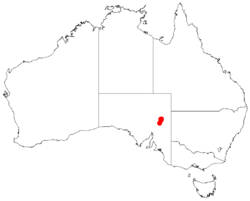Biology:Acacia araneosa
| Balcanoona Wattle | |
|---|---|
| Scientific classification | |
| Kingdom: | Plantae |
| Clade: | Tracheophytes |
| Clade: | Angiosperms |
| Clade: | Eudicots |
| Clade: | Rosids |
| Order: | Fabales |
| Family: | Fabaceae |
| Subfamily: | Caesalpinioideae |
| Clade: | Mimosoid clade |
| Genus: | Acacia |
| Species: | A. araneosa
|
| Binomial name | |
| Acacia araneosa Whibley
| |

| |
Acacia araneosa, commonly known as Balcanoona wattle or spidery wattle, is a shrub belonging to the genus Acacia and the subgenus Phyllodineae that is native to South Australia.
Description
The erect, small and wispy shrub that typically grows to a height of 3 to 8 metres (10 to 26 ft). It blooms irregularly throughout the year and produces yellow flowers.[1] It has slender, glabrous flexuose, red-brown coloured branchlets. The pendulous, thickly filiform phyllodes are usually terete to quadrangular. The phyllodes have a length of 18 to 35 cm (7.1 to 13.8 in) but can be as long as 69 cm (27 in) and have a width of 1 to 2 mm (0.039 to 0.079 in) and narrow to the apex.[2]
Taxonomy
The species was first formally described by the botanist D.J.E. Whibley in the 1976 work by Whibley and B.J. Walby Acacia araneosa (Fabaceae subfam. Mimosoideae), a new species from South Australia as published in the Contributions from the Herbarium Australiense. It was reclassified as Racosperma araneosum in 2003 then transferred back to the genus Acacia in 2005.[3]
Distribution
It has a limited distribution in arid conditions of central South Australia in the northern Flinders Range from Balcanoona to Arkaroola where it is found on rocky slopes, ridges and hills in skeletal soils[1] over Skillogallee dolamite, reputed to be highly magnesic. It is often a part of open woodland or shrubland communities along with Eucalyptus gillii and Triodia irritans.[2]
See also
References
- ↑ Jump up to: 1.0 1.1 "Acacia araneosa (Leguminosae) Balcanoona Wattle". Seeds of South Australia. South Australian Seed Conservation Centre. 2018. https://spapps.environment.sa.gov.au/SeedsOfSA/speciesinformation.html?rid=110.
- ↑ Jump up to: 2.0 2.1 "Acacia araneosa". World Wide Wattle. Western Australian Herbarium. http://worldwidewattle.com/speciesgallery/araneosa.php.
- ↑ "Acacia araneosa Whibley". Atlas of Living Australia. Global Biodiversity Information Facility. https://bie.ala.org.au/species/http://id.biodiversity.org.au/node/apni/2919802#names.
Wikidata ☰ Q9562247 entry
 |

